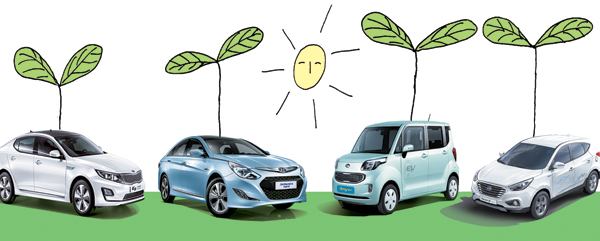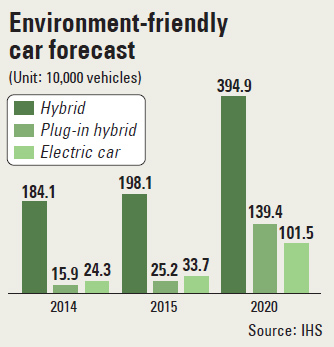Map to fuel efficiency unfolding at Hyundai

The company said the current environmentally friendly car market of 2.2 million cars will grow to 6.4 million in 2020.
“We will try to develop a system that can provide the best fuel efficiency, core technology for auto parts and price competitiveness for environment-friendly cars,” said a Hyundai spokesman. “The competition is getting tougher every year and what we are trying to do isn’t only a strategy against foreign competition, but a way to create new demand.”
The two companies currently sell four hybrid electric vehicles (HEVs), including Hyundai’s Grandeur Hybrid and Sonata Hybrid and Kia’s K5 Hybrid and K7 Hybrid.

The companies currently don’t have any plug-in hybrid electric vehicles (PHEVs), but it will introduce six models starting with the Sonata PHEV next year. A PHEV is similar to a hybrid electric vehicle (HEV), but has a larger battery that can be charged by plugging it into a standard 220V electric outlet. It also offers better mileage. The automotive group said it will also develop models bigger than the Sonata PHEV.
Hyundai said the market will grow fast, since the United States, Europe and China give subsidies to PHEV buyers and offer some incentives to automakers to develop cars with better fuel efficiency.
Kia currently sells two electric vehicles (EVs) - Soul and Ray - and will not develop any new models. Instead, the company will focus on improving the fuel efficiency of existing cars and developing next-generation batteries. Kia also wants to improve its 148-kilometer (92-mile) range per charge.
Hyundai said it will also introduce another hydrogen fuel cell electric vehicle (FCEV). The company this year started selling the Tucson ix FCEV in Europe. The vehicle has a 100-kilowatt fuel cell stack and a 100-kilowatt drive motor that produces a maximum speed of 160 kilometers per hour (99 miles per hour) with a range of 415 kilometers per charge.
The company said its goal is to sell more than 10,000 units in Korea by 2025, but the biggest concern is how to lower the Tucson ix FCEV’s current price tag of 150 million won ($136,900).
BY KWON SANG-SOO [sakwon80@joongang.co.kr]










with the Korea JoongAng Daily
To write comments, please log in to one of the accounts.
Standards Board Policy (0/250자)